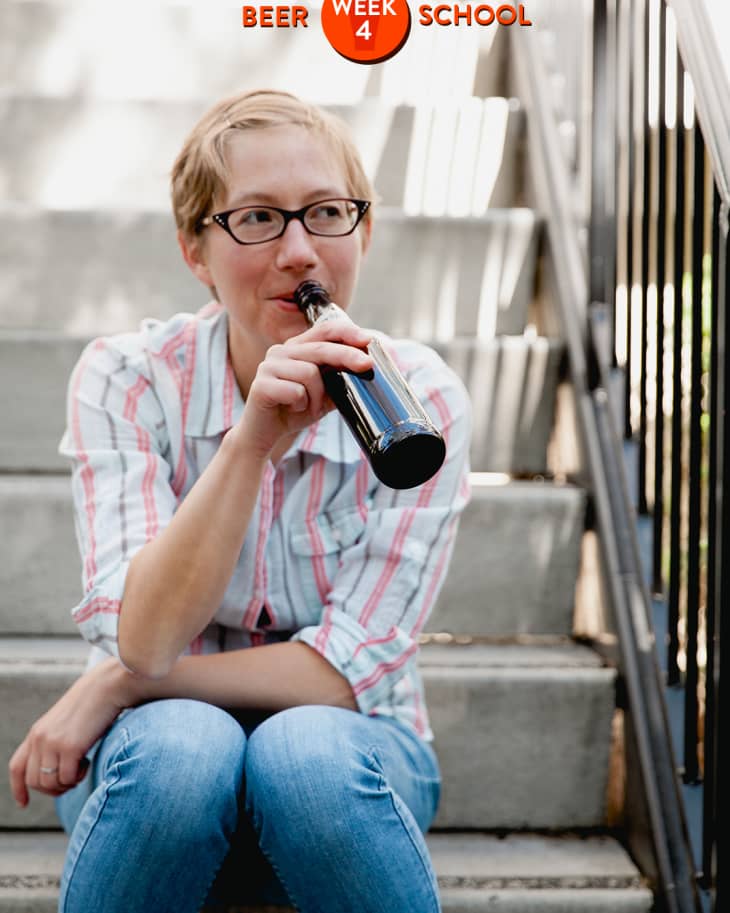Weekend Assignment: 5 Things to Do While You Wait to Bottle Your Beer
- Today’s topic: A few ideas for passing the time until your homebrew is ready.
- The Kitchn’s Beer School: 20 lessons, 7 assignments to brew your first 1-gallon batch of beer.
- Sign up & see all the assignments! The Kitchn’s Beer School
One more week until your beer will be ready to bottle, and another few weeks after that until it’s ready to drink — how can we make that time pass more swiftly? Well, one answer is obvious: Make another batch of beer! Beyond this, I have a few ideas that I think you’ll like.
1. Drink beer!
This one is a personal favorite, admittedly. Technically, you’re not “drinking” — you’re researching. Pick up a beer or a style that you’ve never tried before and give it a go. Challenge yourself to pick apart the hops or the malts before reading the label. Take notes and think about what you might like (or not) in your next homebrew.
2. Throw a beer-tasting party.
When drinking by yourself gets lonely (or worrisome to family members), it’s time to throw a party! Beer-tasting parties are great because you have the opportunity to try several beers side-by-side — something you don’t often get to do outside of a tap room. You can ask each person to bring a beer they love and enjoy the randomness of what arrives at your door, or you can organize the tasting around a theme, like Belgian beers, West Coast versus East Coast IPAs, beers of one particular style, or a bunch of beers from the same brewery.
3. Sample some hops.
You shouldn’t really eat whole hops, but you can certainly smell them. Pick up a few different varieties at your homebrew store, add a teaspoon of each to individual cups, and pour hot water over the top. This will activate the aroma compounds and give you a really nice sense of what each hop is like on its own. Try combining a few to see how the aromas play off each other. You can also taste a sip of the liquid to see what flavors you pick up.
4. Find a homebrew club.
If you live in an area that has a homebrew store, chances are you’ll be able to find a homebrew club. These are groups of dedicated homebrewers who get together for everything from homebrew samplings to brewery tours, and they are almost always open to new members. If you can’t find a homebrew club nearby, you can find some like-minded homebrewers on forums like HomebrewTalk.com — or you could start your own club!
5. Read a good book.
My collection of books on beer, brewing, and fermentation has grown from one shelf to two shelves, and is now threatening a third. These are a few of my favorites for everything from inspiration and new recipes to getting a deep-dive into brewing science (and, of course, there’s my own book, which I humbly recommend!):
- The Complete Joy of Homebrewing by Charlie Papazian: This is widely considered the bible of homebrewing, and it’s the book that guided me through my first homebrews. It’s split into sections for the beginner, intermediate, and advanced homebrewer, with tons of solid information for each.
- The Drunken Botanist by Amy Stewart: This is not a homebrewing book, per se, but it is an encyclopedia-like collection of all the various plants that have been used to make beer, liquor, and other alcohols throughout history. It’s a seriously fascinating read, and it’s given me a lot of inspiration for homebrews.
- The Complete Beer Course by Joshua M. Bernstein: Here’s a great introduction to the wide and wily family of beers. The book walks you through tasting beers and understanding their components, as well as some of the history of famous styles and how they’ve intermarried over the years. (His first book is also a fun read.)
- Designing Great Beers by Ray Daniels: Here’s your science read for the day! If you’re interested in going out on your own and developing some homebrew recipes, this book is a must-read. It goes into great depth on all sorts of brewing details, like yeast pitch rates and optimal hopping ratios.
- Make Some Beer by Erica Shea and Stephen Valand: These two are the minds behind Brooklyn Brewshop’s 1-gallon beer kits, which I think
are awesome
Make Some Beer includes fun clone brews from breweries around the globe, and their first book has a lot of their original beer kit recipes. - Beer Craft by William Bostwick and Jessi Rymill: If you’re a visual learner, this is the book for you. The graphic illustrations clearly explain each part of the brewing process in a way that feels very approachable and intuitive. This book is also a great resource for designing your own brews if you’re not quite up to the technical challenge of Daniels’ book.
What about you? Feel free to give a shout-out to your local homebrew club, a favorite new beer you’ve tried, a book you love, or any other time-killing activity!
Brew Better Beer: A Companion to Beer School
I love brewing beer so much, I wrote a book about it! Brew Better Beer (May 2015, Ten Speed Press) is a complementary guide to Beer School. Take a look for even more nerdy details about homebrewing, how to brew 5-gallon batches, and plenty of recipes for different beers.
→ Find it: Brew Better Beer by Emma Christensen
With The Kitchn’s Beer School, we’ll teach you how to brew your own beer at home — and brew it with confidence. In 20 lessons and 7 weekend assignments, we’ll get you set up with your own home brewery, walk you through your first brew day, show you how to bottle your beer, and then toast you on your first pint. Ready to brew your first beer? Join us!
